Shape Memory Properties and Microstructure of FeNiCoAlTaB Shape Memory Alloys
Abstract
1. Introduction
2. Materials and Methods
3. Results
3.1. Microstructure and Composition Analysis Results
3.2. X-ray Diffraction Results
3.3. Thermomagnetic Results
3.4. EBSD Results
3.5. Shape Memory Effect Test Results
4. Discussion
5. Conclusions
- The 98.5% cold-rolled FeNiCoAlTaB alloy that underwent annealing treatment at 1250 °C for 0.5 h exhibited a strong intensity of texture, with 31.64 in the <100> orientation, and the average grain size was 360 μm. Increasing the annealing time to 1 h reduced the intensity of the recrystallized texture to 23.19. The fraction of LABs for the samples after annealing at 1250 °C for 0.5 h was 24.6% and annealing at 1250 °C for 1 h was 16.1%;
- Phase transformations were observed with the SQUID measurements under the magnetic fields of 0.05 and 7 Tesla for both 700 °C-6 h to 700 °C-12 h aging conditions. The martensitic start temperatures increased from -113 °C to -97 °C as the aging time was increased from 700 °C-6 h to 700 °C-12 h. Both aging samples reach the saturation magnetization of 140 emu/g when the magnetic field is 7 Tesla;
- According to the three-point-bending result, the 700 °C-6 h and 700 °C-12 h samples exhibited a shape memory recoverable strain of 0.2% at a stress level of 800 MPa and 0.8% at a stress level of 400 MPa. The recoverable strains observed during three-point-bending were lower than the theoretically predicted values. The difference is believed to have been caused by the smaller fraction of LABs, as well as the slightly lower than expected grain size in the present study.
Author Contributions
Funding
Data Availability Statement
Acknowledgments
Conflicts of Interest
References
- Otsuka, K.; Wayman, C.M. Shape Memory Materials; Cambridge University Press: Cambridge, UK, 1998; pp. 117–132. [Google Scholar]
- Jani, J.M.; Leary, M.; Subic, A.; Gibson, M.A. A review of shape memory alloy research, applications and opportunities. Mater. Des. 2014, 56, 1078–1113. [Google Scholar] [CrossRef]
- Wang, X.; Yu, J.; Liu, J.; Chen, L.; Yang, Q.; Wei, H.; Sun, J.; Wang, Z.; Zhang, Z.; Zhao, G.; et al. Effect of process parameters on the phase transformation behavior and tensile properties of NiTi shape memory alloys fabricated by selective laser melting. Addit. Manuf. 2020, 36, 101545. [Google Scholar] [CrossRef]
- Chen, Y.; Sun, S.; Zhang, T.; Zhou, X.; Li, S. Effects of post-weld heat treatment on the microstructure and mechanical properties of laser-welded NiTi/304SS joint with Ni filler. Mater. Sci. Eng. A 2019, 771, 138545. [Google Scholar] [CrossRef]
- Deng, H.; Chen, Y.; Jia, Y.; Pang, Y.; Zhang, T.; Wang, S.; Yin, L. Microstructure and mechanical properties of dissimilar NiTi/Ti6Al4V joints via back-heating assisted friction stir welding. J. Manuf. Process. 2021, 64, 379–391. [Google Scholar] [CrossRef]
- Tanaka, Y.; Himuro, Y.; Kainuma, R.; Sutou, Y.; Omori, T.; Ishida, K. Ferrous polycrystalline shape-memory alloy showing huge superelasticity. Science 2010, 27, 1488–1490. [Google Scholar] [CrossRef] [PubMed]
- Omori, T.; Abe, S.; Tanaka, Y.; Lee, D.; Ishida, K.; Kainuma, R. Thermoelastic martensitic transformation and superelasticity in Fe–Ni–Co–Al–Nb–B polycrystalline alloy. Scr. Mater. 2013, 69, 812–815. [Google Scholar] [CrossRef]
- Lee, D.; Omori, T.; Kainuma, K. Ductility enhancement and superelasticity in Fe–Ni–Co–Al–Ti–B polycrystalline alloy. J. Alloys Compd. 2014, 617, 120–123. [Google Scholar] [CrossRef]
- Tseng, L.W.; Ma, J.; Karaman, I.; Wang, S.J.; Chumlyakov, Y. Superelastic response of the FeNiCoAlTi single crystals under tension and compression. Scr. Mater. 2015, 101, 1–4. [Google Scholar] [CrossRef]
- Chumlyakov, Y.I.; Kireeva, I.V.; Pobedennaya, P.; Krooβ, P.; Niendorf, T. Rubber-like behaviour and superelasticity of [001]-oriented FeNiCoAlNb single crystals containing γ- and β-phase particles. J. Alloys Compd. 2021, 856, 158158. [Google Scholar] [CrossRef]
- Omori, T.; Ando, K.; Okano, M.; Xu, X.; Tanaka, Y.; Ohnuma, I.; Kainuma, R.; Ishida, K. Superelastic effect in polycrystalline ferrous alloys. Science 2011, 333, 68–71. [Google Scholar] [CrossRef]
- Tseng, L.W.; Ma, J.; Wang, S.J.; Karaman, I.; Kaya, M.; Luo, Z.P.; Chumlyakov, Y.I. Superelastic response of a single crystalline FeMnAlNi shape memory alloy under tension and compression. Acta Mater. 2015, 89, 374–383. [Google Scholar] [CrossRef]
- Tseng, L.W.; Ma, J.; Hornbuckle, B.; Karaman, I.; Thompson, G.B.; Luo, Z.; Chumlyakov, Y. The effect of precipitates on the superelastic response of [100] oriented FeMnAlNi single crystals under compression. Acta Mater. 2015, 97, 234–244. [Google Scholar] [CrossRef]
- Ma, J.; Kockar, B.; Evirgen, A.; Karaman, I.; Luo, Z.; Chumlyakov, Y. Shape memory behavior and tension–compression asymmetry of a FeNiCoAlTa single-crystalline shape memory alloy. Acta Mater. 2012, 60, 2186–2195. [Google Scholar] [CrossRef]
- Ma, J.; Hornbuckle, B.; Karaman, I.; Thompson, G.B.; Luo, Z.; Chumlyakov, Y. The effect of nanoprecipitates on the superelastic properties of FeNiCoAlTa shape memory alloy single crystals. Acta Mater. 2013, 61, 3445–3455. [Google Scholar] [CrossRef]
- Czerny, M.; Cios, G.; Maziarz, W.; Chumlyakov, Y.; Chulist, R. Studies on the Two-Step Aging Process of Fe-Based Shape Memory Single Crystals. Materials 2020, 13, 1724. [Google Scholar] [CrossRef]
- Czerny, M.; Maziarz, W.; Cios, G.; Wojcik, A.; Chumlyakov, Y.I.; Schell, N.; Fitta, M.; Chulist, R. The effect of heat treatment on the precipitation hardening in FeNiCoAlTa single crystals. Mater. Sci. Eng. Mater. A 2020, 784, 139327. [Google Scholar] [CrossRef]
- Geng, Y.; Lee, D.; Xu, X.; Nagasako, M.; Jin, X.; Omori, T.; Kainuma, R. Coherency of ordered γ’ precipitates and thermoelastic martensitic transformation in FeNiCoAlTaB alloys. J. Alloys Compd. 2015, 628, 287–292. [Google Scholar] [CrossRef]
- Zhang, C.; Zhu, C.; Shin, S.; Casalena, L.; Vecchio, K. Grain boundary precipitation of tantalum and NiAl in superelastic FeNiCoAlTaB alloy. Mater. Sci. Eng. A 2019, 743, 372–381. [Google Scholar] [CrossRef]
- Zhao, H.; Fu, H.; Xie, J.; Zhang, Z. Effects of solution treatment on microstructure and superelasticity of FeNiCoAlTaB alloy. Mater. Res. Express 2018, 5, 016508. [Google Scholar] [CrossRef]
- Fu, H.; Li, W.; Song, S.; Jiang, Y.; Xie, J. Effects of grain orientation and precipitates on the superelasticity in directionally solidified FeNiCoAlTaB shape memory alloy. J. Alloys Compd. 2016, 684, 556–563. [Google Scholar] [CrossRef]
- Choi, W.S.; Pang, E.L.; Choi, P.P.; Schuh, C.A. FeNiCoAlTaB superelastic and shape-memory wires with oligocrystalline grain structure. Scr. Mater. 2020, 188, 1–5. [Google Scholar] [CrossRef]
- Zhang, C.; Yu, Q.; Tang, Y.T.; Xu, M.; Wang, H.; Zhu, C.; Ell, J.; Zhao, S.; MacDonald, B.E.; Cao, P.; et al. Strong and ductile FeNiCoAl-based high-entropy alloys for cryogenic to elevated temperature multifunctional applications. Acta Mater. 2023, 242, 118449. [Google Scholar] [CrossRef]
- Fu, H.; Zhao, H.; Shilei, S.; Zhang, Z.; Xie, J. Evolution of the cold-rolling and recrystallization textures in FeNiCoAlNbB shape memory alloy. J. Alloys Compd. 2016, 628, 287–292. [Google Scholar] [CrossRef]
- Tseng, L.W.; Chen, C.H.; Chen, W.C.; Cheng, Y.; Lu, N.H. Shape memory properties and microstructure of new iron-based FeNiCoAlTiNb shape memory alloys. Crystals 2021, 11, 1253. [Google Scholar] [CrossRef]
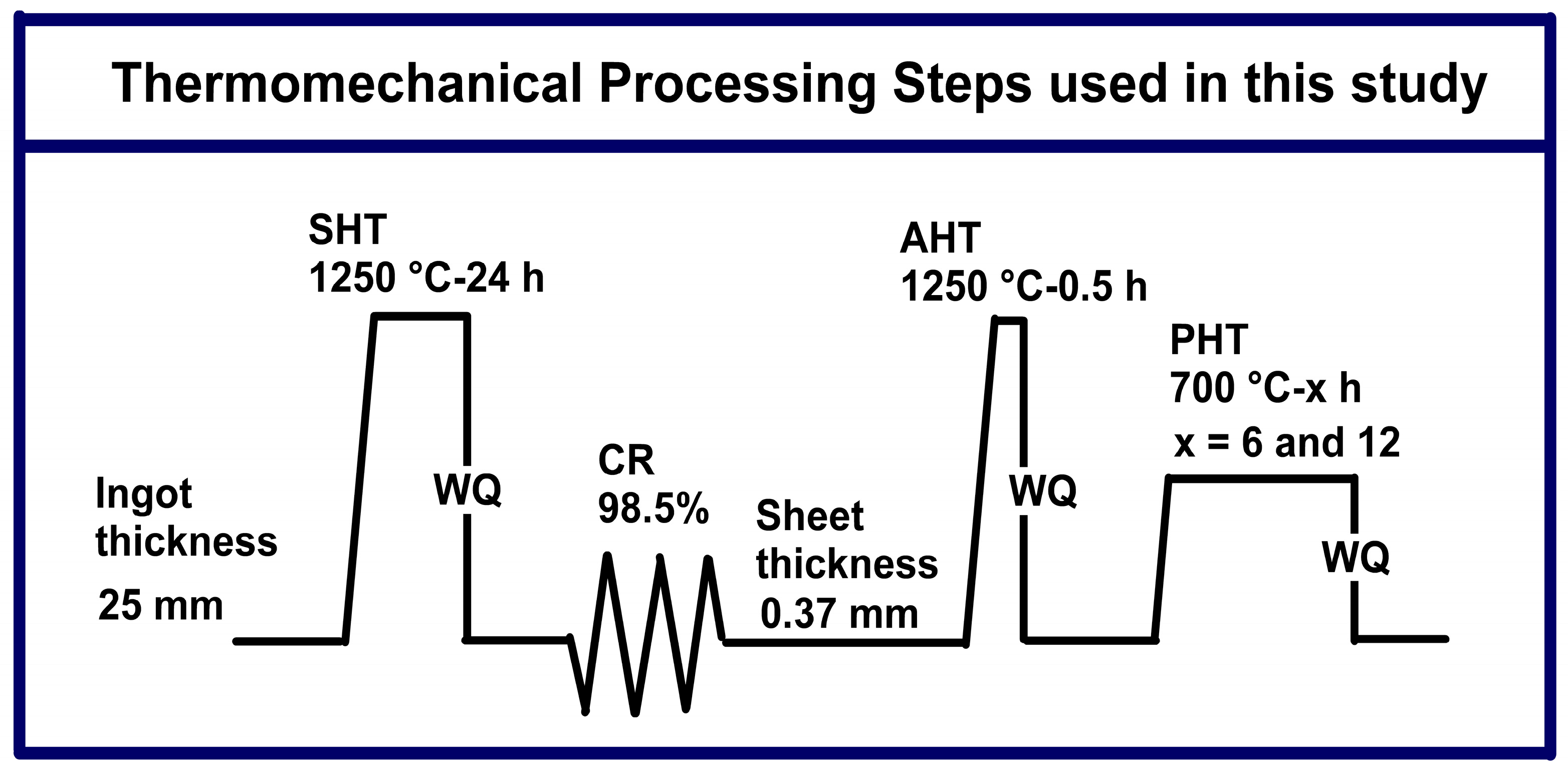


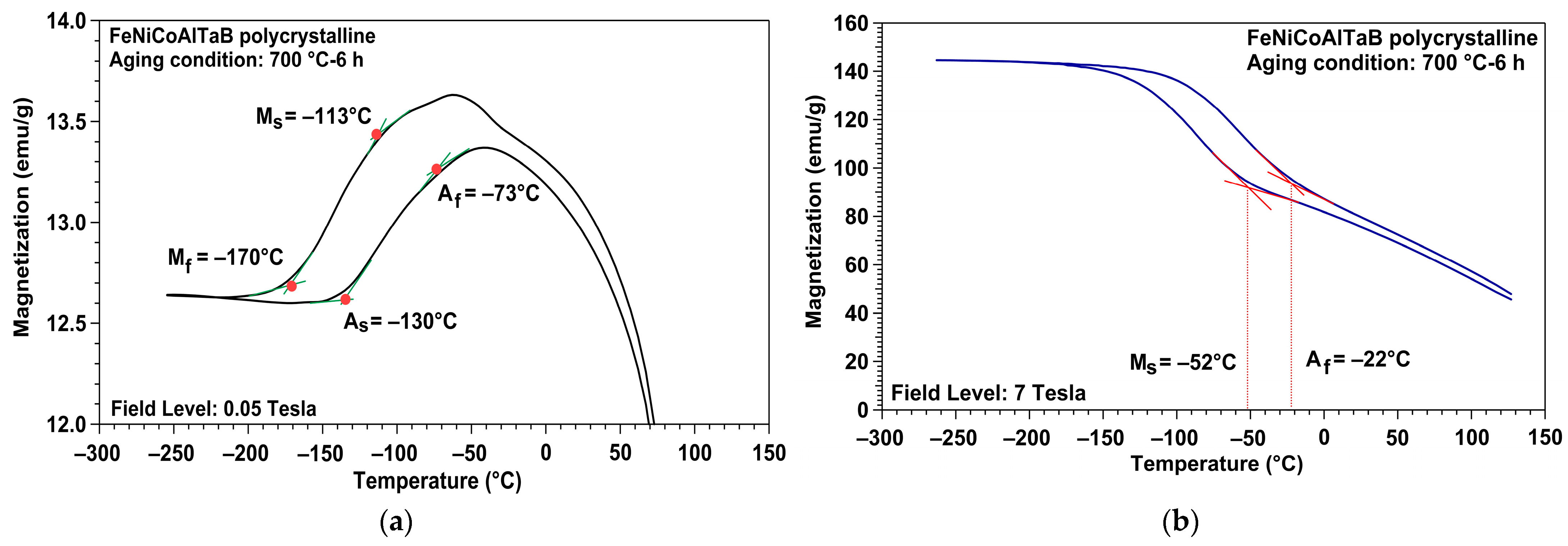
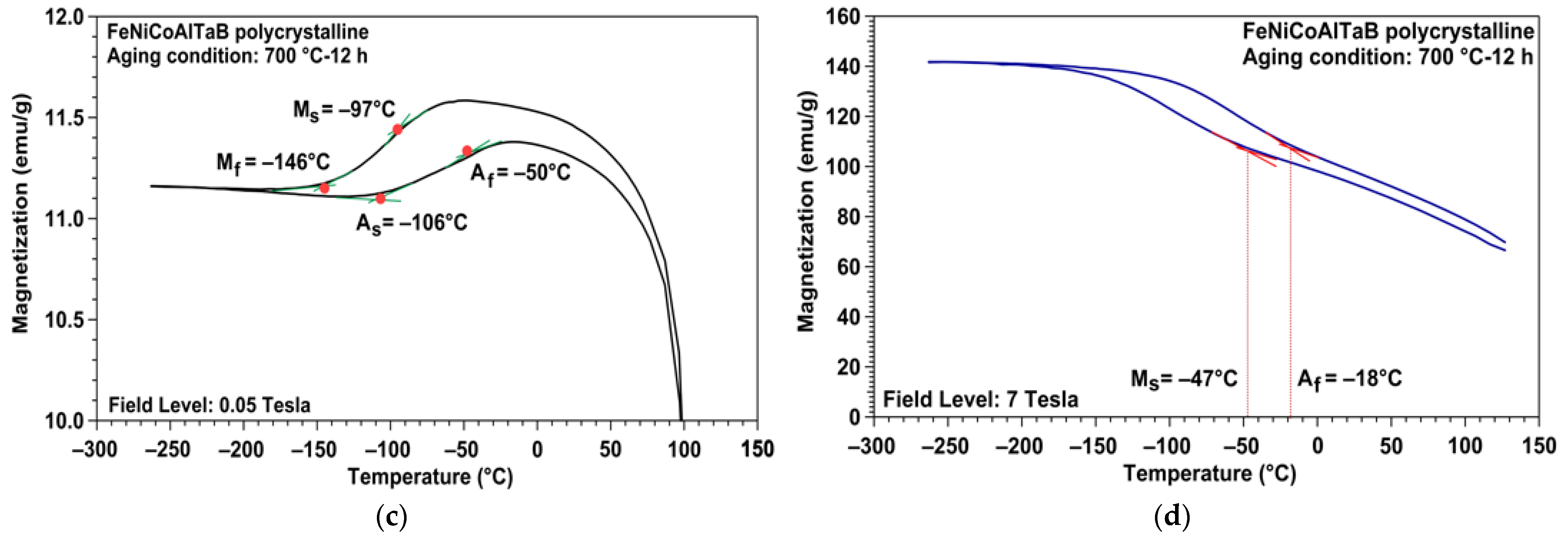

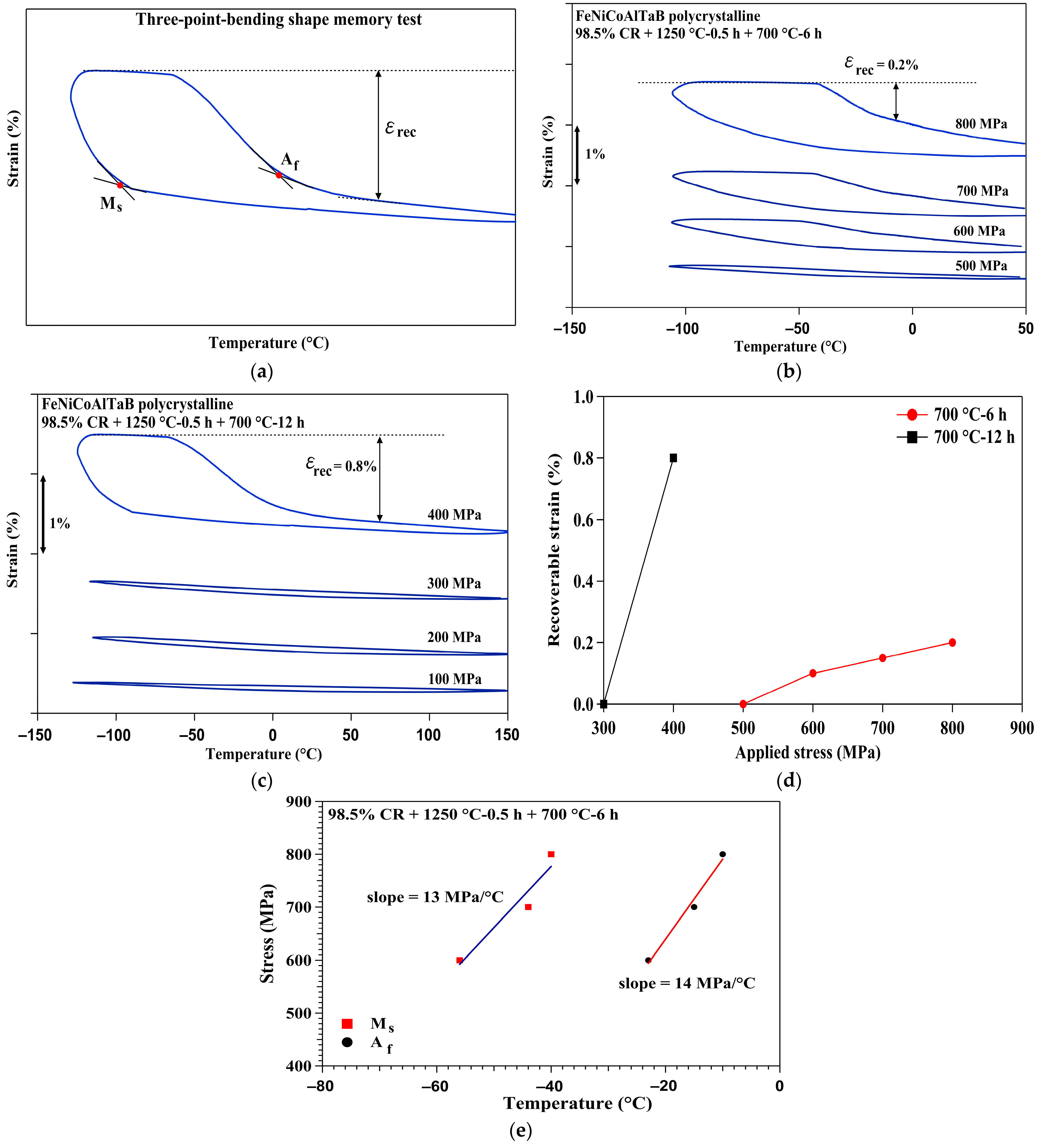
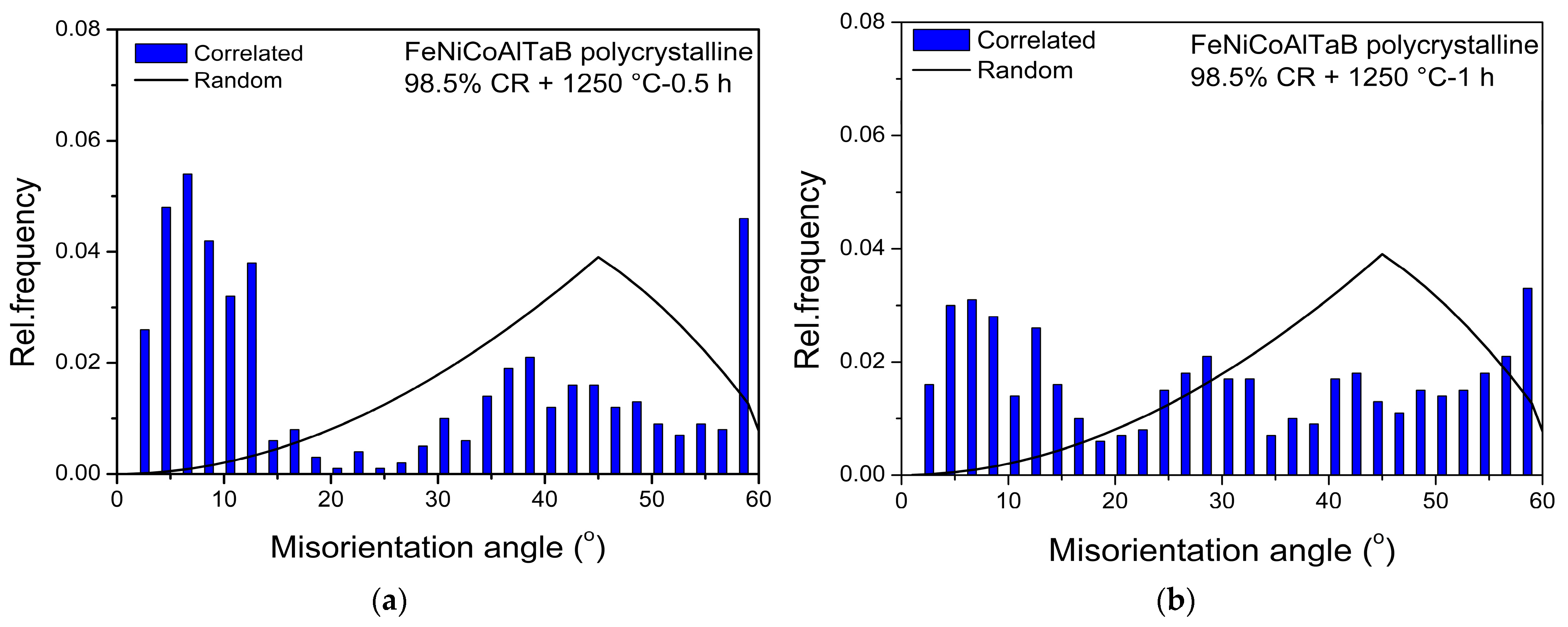
| Sample Condition | Fe | Ni | Co | Al | Ta | B |
|---|---|---|---|---|---|---|
| 98.5% CR | 45.57 | 25.9 | 16.32 | 9.74 | 2.43 | 0.04 |
| 98.5% CR + 1250 °C-0.5 h | 45.5 | 27.16 | 16.83 | 8.38 | 2.08 | 0.05 |
| nominal composition [4] | 40.95 | 28 | 17 | 11.5 | 2.5 | 0.05 |
| Thermo-Mechanical Processing | Vickers Hardness (HV) |
|---|---|
| 98.5% CR | 429 ± 9 |
| 98.5% CR + 1250 °C-0.5 h | 223 ± 5 |
| 98.5% CR + 1250 °C-0.5 h + 700 °C-6 h | 434 ± 6 |
| 98.5% CR + 1250 °C-0.5 h + 700 °C-12 h | 490 ± 4 |
| 98.5% CR + 1250 °C-0.5 h + 700 °C-24 h | 424 ± 8 |
| Aging Condition | Magnetic Field | Transformation Temperature | Temperature Hysteresis |
|---|---|---|---|
| 700 °C-6 h | 0.05 T | Af = −73 °C and Ms = −113 °C | 40 °C |
| 700 °C-6 h | 7 T | Af = −52 °C and Ms = −22 °C | 30 °C |
| 700 °C-12 h | 0.05 T | Af = −50 °C and Ms = −97 °C | 40 °C |
| 700 °C-12 h | 7 T | Af = −47 °C and Ms = −18 °C | 29 °C |
Disclaimer/Publisher’s Note: The statements, opinions and data contained in all publications are solely those of the individual author(s) and contributor(s) and not of MDPI and/or the editor(s). MDPI and/or the editor(s) disclaim responsibility for any injury to people or property resulting from any ideas, methods, instructions or products referred to in the content. |
© 2023 by the authors. Licensee MDPI, Basel, Switzerland. This article is an open access article distributed under the terms and conditions of the Creative Commons Attribution (CC BY) license (https://creativecommons.org/licenses/by/4.0/).
Share and Cite
Tseng, L.-W.; Lee, P.-Y.; Lu, N.-H.; Hsu, Y.-T.; Chen, C.-H. Shape Memory Properties and Microstructure of FeNiCoAlTaB Shape Memory Alloys. Crystals 2023, 13, 852. https://doi.org/10.3390/cryst13050852
Tseng L-W, Lee P-Y, Lu N-H, Hsu Y-T, Chen C-H. Shape Memory Properties and Microstructure of FeNiCoAlTaB Shape Memory Alloys. Crystals. 2023; 13(5):852. https://doi.org/10.3390/cryst13050852
Chicago/Turabian StyleTseng, Li-Wei, Po-Yu Lee, Nian-Hu Lu, Yi-Ting Hsu, and Chih-Hsuan Chen. 2023. "Shape Memory Properties and Microstructure of FeNiCoAlTaB Shape Memory Alloys" Crystals 13, no. 5: 852. https://doi.org/10.3390/cryst13050852
APA StyleTseng, L.-W., Lee, P.-Y., Lu, N.-H., Hsu, Y.-T., & Chen, C.-H. (2023). Shape Memory Properties and Microstructure of FeNiCoAlTaB Shape Memory Alloys. Crystals, 13(5), 852. https://doi.org/10.3390/cryst13050852








